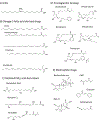Nitro-fatty acids: New drug candidates for chronic inflammatory and fibrotic diseases
- PMID: 29944935
- PMCID: PMC6280193
- DOI: 10.1016/j.niox.2018.06.006
Nitro-fatty acids: New drug candidates for chronic inflammatory and fibrotic diseases
Abstract
Nitrated oleic acid (NO2-OA) was first identified in 2003, and after the characterization of its formation and thiol reactivity, it was used as a prototypical molecule to investigate the physiological actions of endogenous nitrated fatty acids (NO2-FA). Based on in vitro observations showing significant activation of cytoprotective and anti-inflammatory signaling responses by NO2-FA, experiments were designed to determine their pharmacological potential. Supported by strong intellectual protection and favorable pharmacokinetic and pharmacodynamic data, 10-NO2-OA (CXA-10) underwent pharmaceutical development as a drug to treat fibrotic and inflammatory diseases. NO2-FA are at the intersection of three unconventional drug candidate classes that include 1) fatty acids, 2) metabolic intermediates and 3) electrophilic molecules. These three groups use different scaffolds for drug development, are characterized by broad activities and are individually gaining traction as alternatives to mono-target drug therapies. In particular, NO2-FA share key characteristics with currently approved pharmacological agents regarding reactivity, distribution, and mechanism of action. This review first presents the characteristics, liabilities, and opportunities that these different drug candidate classes display, and then discusses these issues in the context of current progress in the preclinical and clinical development of NO2-FA as drugs. Lessons learned from the novel approaches presented herein were considered early on during development to structurally define and improve NO2-FA and their disease targets.
Keywords: Bardoxolone-me; Clinical trial; Dimethyl fumarate; Electrophiles; Fibrosis; Inflammation; Nf-kB; Nitro-fatty acid; Nitroalkene; Nrf2; Preclinical development.
Copyright © 2018. Published by Elsevier Inc.
Figures
Similar articles
-
Electrophilic characteristics and aqueous behavior of fatty acid nitroalkenes.Redox Biol. 2021 Jan;38:101756. doi: 10.1016/j.redox.2020.101756. Epub 2020 Oct 12. Redox Biol. 2021. PMID: 33181478 Free PMC article.
-
Electrophilic fatty acid nitroalkenes are systemically transported and distributed upon esterification to complex lipids.J Lipid Res. 2019 Feb;60(2):388-399. doi: 10.1194/jlr.M088815. Epub 2018 Dec 13. J Lipid Res. 2019. PMID: 30545956 Free PMC article.
-
Nitrated fatty acids suppress angiotensin II-mediated fibrotic remodelling and atrial fibrillation.Cardiovasc Res. 2016 Jan 1;109(1):174-84. doi: 10.1093/cvr/cvv254. Epub 2015 Nov 23. Cardiovasc Res. 2016. PMID: 26598510 Free PMC article.
-
Nitro-fatty acid formation and metabolism.Nitric Oxide. 2018 Sep 1;79:38-44. doi: 10.1016/j.niox.2018.07.003. Epub 2018 Jul 10. Nitric Oxide. 2018. PMID: 30006146 Free PMC article. Review.
-
Protection of nitro-fatty acid against kidney diseases.Am J Physiol Renal Physiol. 2016 Apr 15;310(8):F697-F704. doi: 10.1152/ajprenal.00321.2015. Epub 2015 Dec 30. Am J Physiol Renal Physiol. 2016. PMID: 26719362 Free PMC article. Review.
Cited by
-
Editorial of special issue: Pharmacological, gene, and cell-based therapeutics targeting early or late neurodegenerative and neurovascular diseases.Exp Neurol. 2023 Mar;361:114297. doi: 10.1016/j.expneurol.2022.114297. Epub 2022 Dec 13. Exp Neurol. 2023. PMID: 36566701 Free PMC article. No abstract available.
-
Nitro-oleic acid regulates T cell activation through post-translational modification of calcineurin.Proc Natl Acad Sci U S A. 2023 Jan 24;120(4):e2208924120. doi: 10.1073/pnas.2208924120. Epub 2023 Jan 18. Proc Natl Acad Sci U S A. 2023. PMID: 36652486 Free PMC article.
-
Redox properties and human serum albumin binding of nitro-oleic acid.Redox Biol. 2019 Jun;24:101213. doi: 10.1016/j.redox.2019.101213. Epub 2019 May 8. Redox Biol. 2019. PMID: 31170679 Free PMC article.
-
Nitro-Oleic Acid (NO2-OA) Improves Systolic Function in Dilated Cardiomyopathy by Attenuating Myocardial Fibrosis.Int J Mol Sci. 2021 Aug 22;22(16):9052. doi: 10.3390/ijms22169052. Int J Mol Sci. 2021. PMID: 34445757 Free PMC article.
-
Health position paper and redox perspectives - Bench to bedside transition for pharmacological regulation of NRF2 in noncommunicable diseases.Redox Biol. 2025 Apr;81:103569. doi: 10.1016/j.redox.2025.103569. Epub 2025 Mar 3. Redox Biol. 2025. PMID: 40059038 Free PMC article. Review.
References
-
- De Caterina R (2011) n-3 fatty acids in cardiovascular disease. N Engl J Med 364, 2439–2450 - PubMed
-
- Tavazzi L, Maggioni AP, Marchioli R, Barlera S, Franzosi MG, Latini R, et al. (2008) Effect of n-3 polyunsaturated fatty acids in patients with chronic heart failure (the GISSI-HF trial): a randomised, double-blind, placebo-controlled trial. Lancet 372, 1223–1230 - PubMed
-
- Marchioli R, Barzi F, Bomba E, Chieffo C, Di Gregorio D, Di Mascio R, et al. (2002) Early protection against sudden death by n-3 polyunsaturated fatty acids after myocardial infarction: time-course analysis of the results of the Gruppo Italiano per lo Studio della Sopravvivenza nell’Infarto Miocardico (GISSI)-Prevenzione. Circulation 105, 1897–1903 - PubMed
-
- Yokoyama M, Origasa H, Matsuzaki M, Matsuzawa Y, Saito Y, Ishikawa Y, et al. (2007) Effects of eicosapentaenoic acid on major coronary events in hypercholesterolaemic patients (JELIS): a randomised open-label, blinded endpoint analysis. Lancet 369, 1090–1098 - PubMed
-
- (1999) Dietary supplementation with n-3 polyunsaturated fatty acids and vitamin E after myocardial infarction: results of the GISSI-Prevenzione trial. Gruppo Italiano per lo Studio della Sopravvivenza nell’Infarto miocardico. Lancet 354, 447–455 - PubMed
Publication types
MeSH terms
Substances
Grants and funding
LinkOut - more resources
Full Text Sources
Other Literature Sources


